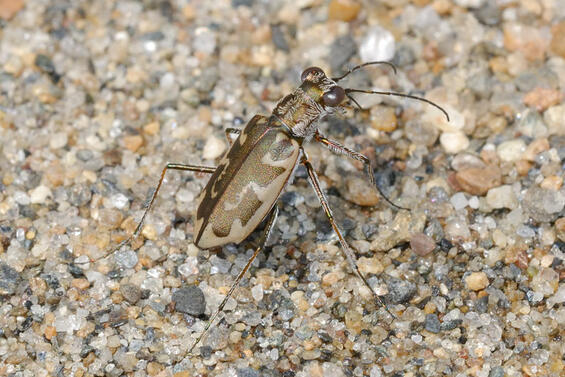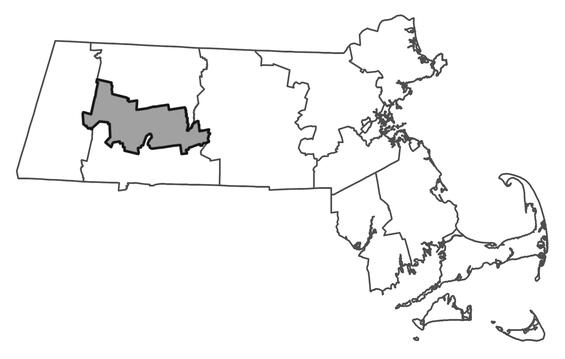- Scientific name: Ellipsoptera puritana
- Species of Greatest Conservation Need (MA State Wildlife Action Plan)
- Endangered (MA Endangered Species Act)
- Threatened (US Endangered Species Act)
Description

Puritan tiger beetle (Ellipsoptera puritana)
Tiger beetles are so named because of their “tiger-like” behavior of chasing down and capturing prey with their long mandibles. The Puritan tiger beetle (Ellipsoptera puritana) is 12-14 mm (0.45-0.55 in) in length (Pearson et al. 2015), bronze in color, and the elytra (wing covers) are marked with transverse and marginal white bands. The grub-like larva of the Puritan tiger beetle has a shiny, iridescent black head, a pronotum (“neck”) covered with setae (hairs), and a long, segmented, white abdomen. The bronzed tiger beetle (Cicindela repanda) resembles the Puritan tiger beetle, although it is more stout. The Puritan tiger beetle is longer and thinner, with more setae on the underside of the abdomen. Unlike the bronzed tiger beetle, the white markings around the outer edge of the elytra of the Puritan tiger beetle are continuous (unbroken).
Life cycle and behavior

The Puritan tiger beetle has a two-year life cycle. Adult Puritan tiger beetles are active from late June through August, with activity peaking in July. They are most active on hot, sunny days, foraging along sandy river shoreline (beach) and preying on small invertebrates. Females lay their eggs in the sand, typically at slightly higher elevation away from the waterline. By late August most, if not all, of the adult beetles have died. Eggs hatch in late August or early September. Larvae inhabit burrows mostly along the upper margin of the beach, where they capture small invertebrate prey. Larvae are small when they enter diapause for the first winter; they continue to feed through the following summer and are fully grown by autumn. The larvae overwinter again, and pupate in late May or early June, the adults emerging several weeks later.
Distribution and abundance
Historically, the Puritan tiger beetle inhabited scattered localities along rivers in New Hampshire, Massachusetts, and Connecticut, as well as the shores of Chesapeake Bay in Maryland. It is now found at only a few locations along rivers in Massachusetts and Connecticut, a reduced and relatively short portion of the Chesapeake Bay shoreline, and one additional site in Kent County, Maryland.

Distribution in Massachusetts. 1999-2024. Based on records in the Natural Heritage Database.
Habitat
In New England, the Puritan tiger beetle inhabits the shoreline of large rivers, specifically sparsely vegetated sand beaches and occasionally silt banks. Inhabited beaches are typically dry, wide, and located at river bends. Beetle larvae live in burrows mostly along the upper margin of the beach or in silt banks.
Healthy habitats are vital for supporting native wildlife and plants. Explore habitats and learn about conservation and restoration in Massachusetts.

River shoreline sand beach, habitat for the Puritan tiger beetle.
Threats
The Puritan tiger beetle is threatened by alteration of the hydrology of its river shoreline habitat, in particular natural flooding that builds and maintains sand beaches by preventing vegetation overgrowth and by depositing sand. Unnatural flooding from dam releases that are voluminous and not during typical flood season may submerge habitat. If such unnatural flooding is too frequent, habitat availability for foraging of both adult beetles and larvae is reduced. Off-road vehicle traffic and other recreational use cause degradation of beach habitat and crushing of larval burrows. Young larvae are most vulnerable to these activities, as their burrows are shallow. Adult beetles may be adversely impacted by insecticide spraying, including drift from adjacent agricultural areas. Other potential threats include invasion by exotic plants and eutrophication or other water pollution. This species has a relatively small geographic range, which may make it especially vulnerable to climate change. Its ability to shift or expand its range in response to climate change, or to adapt within its current range, is not known. Significant changes in precipitation and hydrology are of particular concern.
Conservation
Habitat (river) management is the primary conservation need of the Puritan tiger beetle in Massachusetts. In particular, river hydrology should be restored and managed as close to natural conditions as possible.
Survey and monitoring
In Massachusetts, there is only one population of the Puritan tiger beetle. This population should be monitored annually to document changes in population size and habitat condition.
Management
Management of river hydrology can benefit a diversity of species. For the Puritan tiger beetle, a relatively natural flow regime that builds and maintains sand beaches is of particular importance. Control of invasive exotic plants in such habitat is imperative. Habitat condition should be monitored and management adapted as needed.
Research needs
The basic natural history and conservation needs of the Puritan tiger beetle are relatively well known. However, the future effects of climate change on this species are unpredictable and should be documented.
References
Pearson, D.L., C.B. Knisley, D.P. Duran, and C.J. Kazilek. 2015. A Field Guide to the Tiger Beetles of the United States and Canada. Oxford University Press, New York, New York. 251 pp.
Contact
| Date published: | April 16, 2025 |
|---|